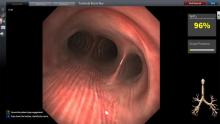When the patient's airway has been difficult to manage, an airway follow-up should be instituted.
REVIEW THE PATIENT CLINICALLY
- to check for 'minor' morbidity such as bruised lips, sore throats
- to check for morbidity such as chipped, loosened teeth that may need a dental referral
- to check for serious morbidity such as laryngeal oedema, laryngeal damage or perforation of the larynx, pharynx, oesophagus. The triad of pyrexia, retrosternal pain and surgical emphysema indicates perforation. This has a high mortality and early treatment with antibiotics, nil orally and ENT review should be initiated early. See Airway Injury during Anaesthesia, Anesthesiology 91; 1703-1711, 1999 for closed claims analysis of 266 cases.
TALK TO THE PATIENT
- express regret/apologise for morbidity
- minor morbidity will resolve in a few days
- persistent hoarseness will need ENT review
- persistent problems need your involvement
- describe the problem - indicate how serious a problem it was/is
- ask them to tell the next anaesthetist of the problem
MAKE ADEQUATE NOTES
- in the anaesthetic records
- in the hospital case notes
- on any front 'problem' sheet
- indicate the precise problem and how you solved it
- specifically address whether facemask ventilation is easy/difficult
WRITE TO THE PATIENT
- back up your oral explanation with details of problem/solution
- copy to the GP
- copy to any Department file or register
- consider whether the patient should be advised to obtain a Medic Alert bracelet
COMPLETE AN AIRWAY ALERT FORM
- this is a useful way of making certain that you have documented events properly
 Download Airway Alert form (Right Click here and 'Save Target As..'
Download Airway Alert form (Right Click here and 'Save Target As..'- this Airway Alert form is described in Anaesthesia 58; 73-77, 2003 and David Ball has kindly agreed to let people use his form. Adapt it as you like with your hospital information.
AIRWAY ALERT
AIRWAY ALERT
|
Name |
|
|
Date of birth Hospital number |
|
|
Home address Telephone Fax |
To the patient:
Please keep this letter safe and show it to your doctor if you are admitted to hospital.
Please show this letter to the anaesthetic doctor if you need an operation.
This letter explains the difficulties that were found during your recent anaesthetic and the information may be useful to doctors treating you in the future.
To the GP:
Please copy this letter with any future referral.
Summary of Airway Management
Date of operation:
Type of operation:
|
Reasons/comments |
||
|
Difficult mask ventilation? |
YES / NO |
|
|
Difficult Direct laryngoscopy? |
YES / NO |
|
|
Difficult tracheal intubation? |
YES / NO |
|
|
Laryngoscopy grade |
1 / 2 / 3 / 4 |
Equipment used:
Other information:
Is awake intubation necessary in the future?
Follow up care (tick when completed)
- Copies of letterOne copy to patient
- One copy to GP
- One copy in case notes
- Anaesthetic chart complete
- Information on front of case notes
- Spoken to patient
- Medic Alert or Difficult Airway
- One copy in anaesthetic department
Name of anaesthetist:
Grade:
Date:
If you require further information please contact the Anaesthetic Department,
